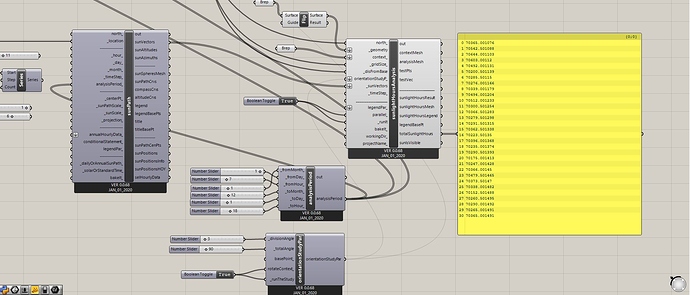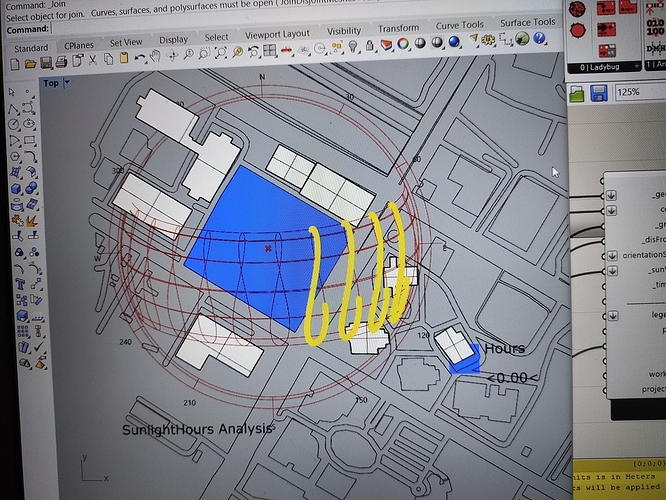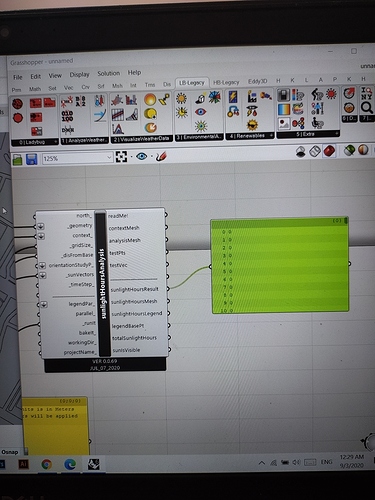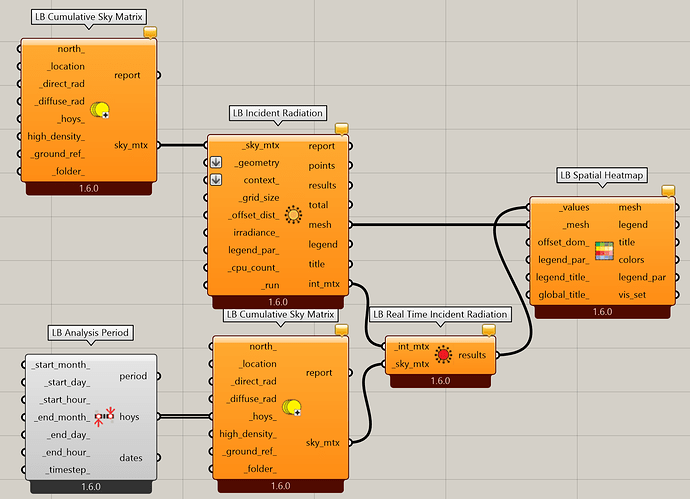Hello friends
I get sunlightHoursAnalysis. The results are hours of the year, which the times of the night are not separated. How can I calculate only the hours that daylight shines on the surface?
thanks in advance
Your question is not clear. sunPath passes ONLY vectors that are above the horizon according to the analysis period you defined (hence, day hours).
-A.
Thankful
The total number of hours in a year is approximately 8700 hours, but in my simulation results, it shows over 70,000 hours !! And I do not know where the problem comes from
I see now. The totalSunlightHours output is supposed to be the average total of direct sunlight received by the test geometry. Seems to be that the calculation is not weighing well the hours per mesh face.
You can report the issue in github. Additionally you can do the calculation yourself taking the results for the test geometry.
The number is 8760.
-A.
Thank you so much abraham
Hi Abraham, I am having a similar issue as Aligoharian, please how would you calculate taking the results for the test geometry? Not sure re the difference between the TotalSunlightHours which seem to be some sort of average, and the SunlightHoursResult, which if I well understood are the hours of sun that hit each grid point, so their sum is a quite big number (in the order of million for a 2ha site). Basically, what’s the best way to compare 2 design options for the same site? E.g. extract the hours of sun hitting i.e. the ground of the first option and compare that number with the hours of sun hitting the ground for the second design option, please? Ideally normalising them by sqm, in case one of the 2 options occupies more ground area than the other (e.g. different density). Many thanks. V.
Hi @viola.maffessanti,
I will divide my answer in two options:
- Is only important the exposure during the analysis period, no matter the hour it happens: There are places/cities that require an amount of hours of solar exposure. For this case i would calculate the % of the revised area EACH hour and then will average between them. I personally don’t like this kind of averages and prefer to show how much area/percentage of the space is exposed hour by hour.
- It is important to differentiate each hour. This is a more quality approach. For instance you can think an hour that the space is more likely to be used or a case where the radiation in the space is important. In the later, the radiation at 8 am is different than the one at 11 am.
Not sure if this is what you asked, but is what i understood. Let me know.
-A.
I am doing sun hour analysis for my site which is surrounded by buildings, but no matter the time i feed in analysis period it always shows zero hours. I am using the updated ladybug component, and i am not able to understand why this error is happening.
The grap
Try flipping the surface of the analysis plane.
Great! I was having the same issue!
Is there a new component that has replaced the MSH2Rad tool in the latest version of Lady bug? I need to run an analysis on a complex geometry for the daylight factor but i cant seem to find one.
Hi Abraham,
Regarding the 2nd option - I’ve done a whole day direct sun hour calculation (21/12, 9:00-15:00). I see the data representing how many hours of direct sun light each point gets, but if I wish to know what are the exact hours that has a direct sun, i.e. 10:00-12:00, is it possible?
Many thanks
As far as i can think you can not tell , AFTER the simulation was done, what are the hours (vectors) that hit the surface.
Saying that, if you try to do a LB radiation simulation you can scroll through the hours and see the amount of radiation you can get at a specific time, like so:
-A.
Great, thank you for your help.
Y
How do we do that, i am having the same problem.Everytime it is showing 0 hours only
Can you tell how did you correct it, i am not able to flip the surface, i made new script again it is showing the same 0 hours



